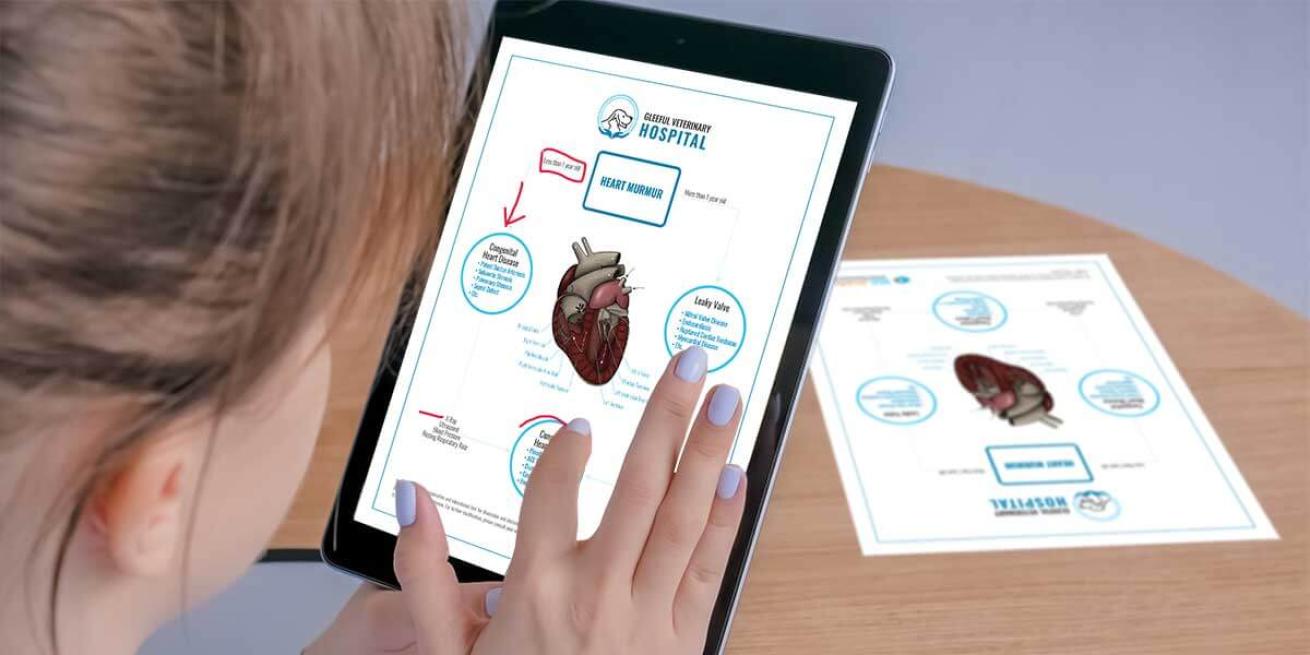
Effective client education is critical when it comes to building trust with your clients. Pet owners play the ultimate role in the overall well-being of their pets, and providing them with clear and concise information is essential to ensuring they have the tools they need. While verbal explanations are valuable, incorporating VCC.Academy diagrams into veterinary client education can significantly enhance the communication process. Our diagrams offer visual aids that simplify complex concepts, enabling pet owners to better understand their pet's health conditions, medical procedures, and treatment options. Let’s explore the benefits of using diagrams to enhance veterinary client education and look at how they can improve the overall experience for both veterinary hospitals and pet owners.
Simplifying Complex Concepts
Diagrams serve as powerful tools for simplifying complex concepts in veterinary medicine. They can break down intricate information into easily understandable components for clients through:
- Visual Representation: Visual information is often easier for people to comprehend and retain compared to verbal explanations alone. Diagrams offer a visual representation of complex concepts, allowing clients to see the information in a tangible format. This visual aid provides a clear overview of the topic at hand, making it easier for clients to grasp and remember.
- Structural Organization: Complex concepts in veterinary medicine often involve multiple interconnected components. Diagrams help organize these components in a structured manner, highlighting relationships and dependencies. By presenting information in a logical and organized layout, diagrams make it easier for clients to follow the flow of concepts and understand the interplay between different elements.
- Simplification of Anatomy: Understanding the anatomy of animals is crucial for comprehending various health conditions and medical procedures. Diagrams can simplify complex anatomical structures by presenting them in a visually accessible format. By breaking down the anatomical components into labeled parts and using different colors or shading, diagrams allow clients to focus on specific areas of interest and better understand the overall structure.
- Step-by-Step Processes: Veterinary procedures, treatments, and surgeries often involve complex step-by-step processes. Diagrams can simplify these processes by visually illustrating each step and its relationship to the larger context. This simplification helps clients visualize the sequence of events, anticipate potential outcomes, and understand the rationale behind each step.
- Comparison and Contrast: Comparative diagrams can be particularly effective in simplifying complex concepts. By presenting two or more entities side by side, clients can easily compare and contrast different aspects. For example, a diagram comparing the healthy and diseased state of an organ can help clients understand the impact of a medical condition and appreciate the importance of treatment.
- Highlighting Key Points: Diagrams can emphasize the most important aspects of a complex concept by using labels, annotations, or call-outs. By directing the client's attention to specific details or key points, diagrams help them focus on essential information and grasp the core concepts without being overwhelmed by excessive details.
- Tailoring Information: Every client has a different level of familiarity with veterinary medicine. Diagrams can be customized to meet the specific needs of individual clients. With our diagrams, veterinarians can add their notes to diagrams in a patient’s chart, ensuring that the information is appropriately tailored to the client for better comprehension.
Clarifying Medical Conditions and Procedures
When pets are diagnosed with medical conditions or require procedures, it is crucial for clients to have a comprehensive understanding of the situation. Diagrams can effectively depict the affected areas, the underlying causes, and the potential consequences of certain conditions. By using our diagrams alongside chart notes to explain conditions, you can help clients comprehend the progression of the illness, available treatment options, and the expected outcomes. This visual aid can reduce confusion and anxiety, allowing clients to actively participate in the decision-making process.
Educating About Preventive Care
Preventive care is essential for maintaining the health and well-being of pets. Diagrams can be particularly helpful in educating clients about topics such as life wellness standards, breeding times, or complex diagnoses that are indicated by specific symptoms. Through visualization, clients can better understand their role in promoting their pet's overall health and caring for them in light of a diagnosis. Additionally, diagrams can illustrate the potential risks associated with neglecting preventive care, motivating clients to take proactive steps in safeguarding their pet's well-being.
Enhancing Communication and Client Engagement
Using diagrams for client education enhances communication and engagement between veterinarians and pet owners. Visual aids enable you to present information in a structured and organized manner that promotes standardized care within your veterinary hospital, ensuring that clients receive accurate and consistent messages. Clients who can visualize and understand the information provided are more likely to actively participate in discussions, ask relevant questions, and comply with treatment plans. This collaborative approach fosters a stronger veterinarian-client relationship, resulting in improved patient care and outcomes.
Incorporating VCC.Academy’s diagrams into veterinary client education has numerous advantages. From simplifying complex concepts and visualizing anatomy to clarifying medical conditions and promoting preventive care, diagrams play a vital role in enhancing the overall communication process. By empowering clients with visual aids, you can ensure that pet owners have a solid understanding of their pet's health, enabling them to make informed decisions and actively participate in their pet's care. As veterinary medicine continues to evolve, leveraging diagrams as an educational tool will undoubtedly contribute to better client education and improved animal welfare.
We invite you to schedule a consultation to discuss how diagrams could benefit your veterinary hospital!

Dr. Brett Bingham, DVM
In the early years of my veterinary practice, I learned the hard way that unintended bad communication can derail your best intentions. Through trial and error, I developed a communication course for myself and my veterinary team to develop confidence and success in the exam room. You can learn these powerful principles too! When great communication practices are put in place AND practiced regularly, you will see consistent growth, happier clients, and better job satisfaction.
Allow me to teach you the tools I’ve learned so that your practice can grow too.
